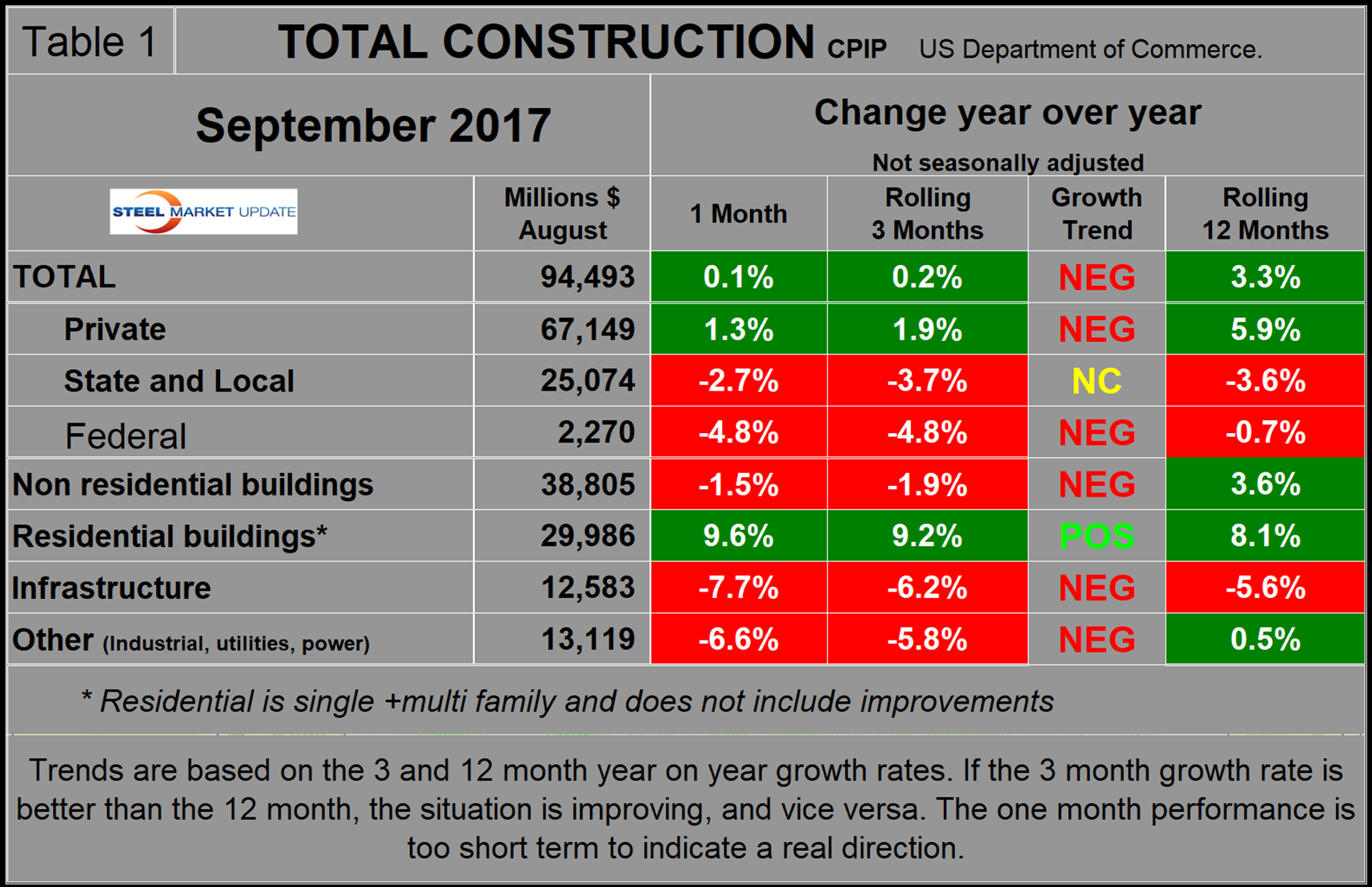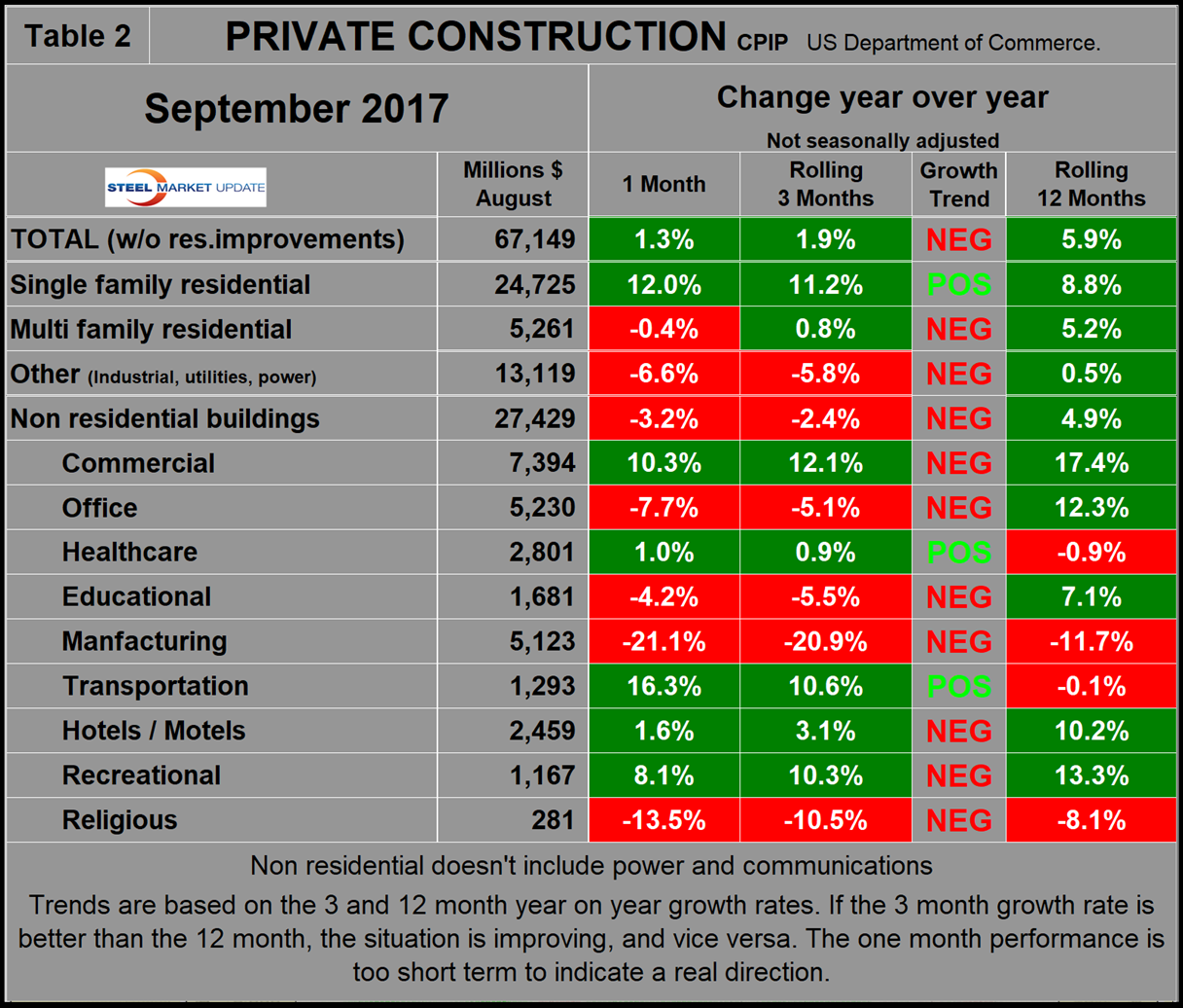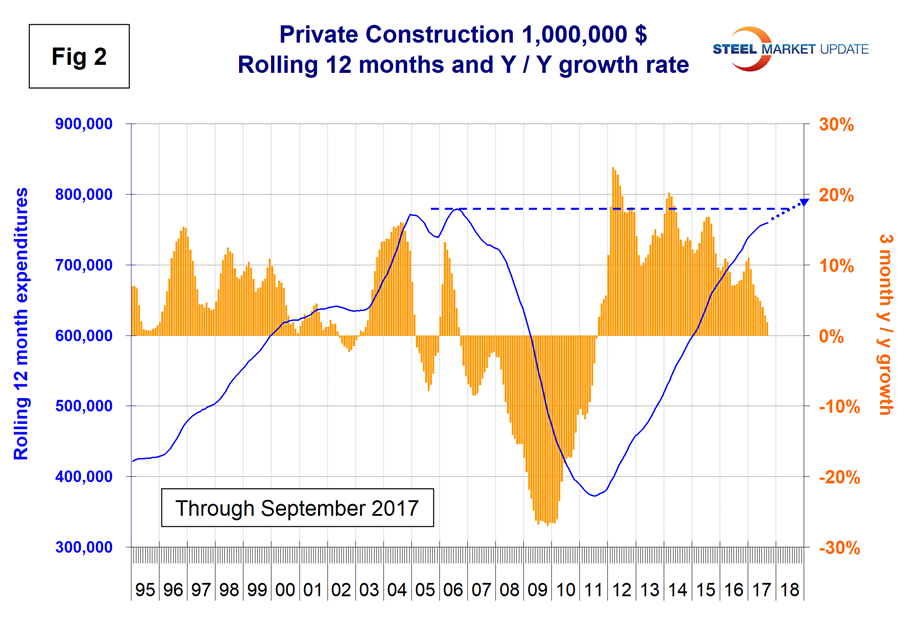Steel Products
Construction Expenditures Through September
Written by Peter Wright
November 6, 2017
SMU Note: This construction market analysis article is normally reserved for our Premium members only, but it is being shared with our entire readership this month. To learn more about our Premium level membership and how it can benefit you, click here.
Growth of total construction spending has almost come to a halt, according to Steel Market Update’s latest analysis of Department of Commerce construction put in place (CPIP) data.
Last month, we reported that total construction expenditures contracted in the three months through August year over year for the first time since November 2011. Based on revisions included in the September CPIP data, the August contraction reversed direction. Total construction increased by 0.3 percent in August and by 0.2 percent in September on a three-month basis year over year. Since construction is extremely seasonal, the growth or contraction we report in this analysis has had seasonality removed by providing only year-over-year comparisons.
![]() At SMU, we analyze the CPIP data with the intent to provide a clear description of activity we believe accounts for about 45 percent of total U.S. steel consumption. See the end of this report for more detail on how we perform this analysis and structure the data. Note that we present non-seasonally adjusted numbers. Much of what you will see in the press may differ from our presentation because others base their comments on adjusted values. Our rationale is that construction is highly seasonal and our businesses function in a seasonal world. Also, we don’t understand how the adjustments are made, nor do we trust them.
At SMU, we analyze the CPIP data with the intent to provide a clear description of activity we believe accounts for about 45 percent of total U.S. steel consumption. See the end of this report for more detail on how we perform this analysis and structure the data. Note that we present non-seasonally adjusted numbers. Much of what you will see in the press may differ from our presentation because others base their comments on adjusted values. Our rationale is that construction is highly seasonal and our businesses function in a seasonal world. Also, we don’t understand how the adjustments are made, nor do we trust them.
{loadposition reserved_message}
Total Construction: Total construction expanded by 0.2 percent in three months through September year over year and followed the 0.3 percent growth in three months through August. These were the lowest growth periods since November 2011. On a rolling 12-month basis year over year, growth in September was 3.3 percent. Since the three-month growth rate is lower than the 12-month rate, we conclude that the rate of growth is slowing. We describe this as negative momentum. September construction expenditures totaled $94.5 billion, which breaks down to $67.1 billion of private work, $25.1 billion of state and locally funded (S&L) work, and $2.3 billion of federally funded work (Table 1). Growth trend columns in all four tables in this report show momentum.
Figure 1 shows total construction expenditures on a rolling 12-month basis as the blue line and the rolling three-month year-over-year growth rate as the brown bars.
Figures 1 through 4 in this analysis have the same format, the result of which is to smooth out variation and eliminate seasonality. We consider four sectors within total construction. These are nonresidential, residential, infrastructure and other. The latter is a catchall and includes industrial, utilities and power. Of these four sectors, only residential buildings had positive momentum in the September data.
The pre-recession peak of total construction on a rolling 12-month basis was $1.028 trillion through September 2006. The low point was $665.1 billion in the 12 months through April 2011. August 2016 through September 2017 on a rolling 12-month basis were the first months to exceed the trillion-dollar level since September 2008. In 12 months through September 2017, construction expenditures totaled $1.037 trillion. (This number excludes residential improvements; see explanation below.)
Private Construction:Table 2 shows the breakdown of private expenditures into residential and nonresidential and subsectors of both. The growth rate of private construction in three months through September was 1.9 percent, down from 11.0 percent in the three months through January as shown by the brown bars in Figure 2.
In our reports earlier in 2017, we projected that total private expenditures would reach the pre-recession high at about the end of this year. This prospect has now died and, based on the present growth rate, we are looking at the end of next year at best. Excluding property improvements, our report shows that single-family residential grew by 11.2 percent with positive momentum, while multifamily residential grew by 0.8 percent with negative momentum.
The Census Bureau reports on construction starts in their housing analysis. In the starts data, the whole project is entered into the database when ground is broken. Single-family starts grew at 5.4 percent in the three months through September, about half the growth rate of CPIP, but multifamily starts contracted by 18.1 percent. Multifamily starts have gone off a cliff since April, and this is now beginning to show in the CPIP data. Within private nonresidential buildings, healthcare and transportation terminals had positive momentum, but all the other sectors are slowing. The third-quarter Federal Reserve Senior Loan Officer Survey indicated there is currently a net decrease in demand for construction and land development loans, and terms for such loans are tightening. The Fed survey reviews changes in the terms of, and demand for, bank loans to businesses on a quarterly basis based on the responses from 73 domestic banks and 24 U.S. branches and agencies of foreign banks. The fourth-quarter report will be released in the next few days.
State and Local Construction: S&L work contracted by 3.7 percent in the rolling three months through September year over year with negative momentum (Table 3).
This overall figure includes both nonresidential buildings and infrastructure. April 2016 was the last month in which S&L expenditures had positive year-over-year growth. Figure 3 shows growth as the brown bars and the rolling 12-month expenditures as the blue line. Nonresidential buildings contracted by 0.6 percent in three months through September. Educational buildings are by far the largest subsector of S&L nonresidential at $6.4 billion in September and eked out a very small positive growth on a rolling three-months basis with negative momentum.
Comparing Figures 2 and 3, S&L construction did not have as severe a decline as private work during the recession and private work bounced back faster. The downturn in S&L (including infrastructure) means that a full recovery to the pre-recession level of expenditures won’t be achieved until well into the next decade, at best.
Drilling down into the private and S&L sectors as presented in Tables 2 and 3 shows which project types should be targeted for steel sales and which should be avoided. There are also regional differences to be considered, data for which is not available from the Commerce Department.
Infrastructure: Infrastructure expenditures had positive growth in the first eight months of last year and have experienced increasingly negative growth every month since then. In the September data, every subsector of infrastructure except conservation contracted. Highways and streets including pavement and bridges account for about two-thirds of total infrastructure expenditures. Highway pavement is the main subcomponent of highways and streets and had a 7.1 percent contraction in three months through September. Bridge work contracted by 3.8 percent (Table 4).
Based on the privately funded toll roads that this writer sees under construction in Texas, we wondered why there isn’t an infrastructure component in the private expenditures section of CPIP. Educational buildings, for example, are subdivided between state and locally funded and privately funded projects. We called the Commerce Department to ask them about this anomaly and were informed that all infrastructure work is included in the S&L section and they don’t plan on making any changes.
Infrastructure expenditures have exceeded the pre-recession high every month since August 2015, but in the last 18 months have been in a downturn (Figure 4).
There is still no sign that the $305 billion authorized in December 2015 by Congress to fund roads, bridges and rail lines has begun to take effect. The long lead time for approvals and project design slows the application of available infrastructure funds, but it seems now there must be some other impediment at work. The 2015 five-year infrastructure bill was the largest reauthorization of federal transportation programs approved by Congress in more than a decade, ending an era of stopgap bills and half-measures that left the Highway Trust Fund nearly broke and frustrated local governments and business groups.
Total Building Construction Including Residential: Figure 5 compares year-to-date expenditures for building construction for 2016 and 2017. Single-family residential is dominant and in the 12 months of 2016 totaled $243 billion, up from $233 billion in 2015. On a rolling 12-month basis through September, single-family residential expenditures exceeded $258 billion. In the first eight months of 2017 year over year, all project segments expanded except manufacturing, religious and lodging, led by commercial (mainly stores), up by 22.6 percent, and offices, up by 5.7 percent.
Figure 6 shows total expenditures and growth of nonresidential building construction. Growth has been slowing this year and went negative in the three months through both August and September year over year for the first time since September 2011.
Explanation: Each month, the Commerce Department issues its construction put in place (CPIP) data, usually on the first working day covering activity one month and one day earlier. Construction put in place is based on spending work as it occurs, estimated for a given month from a sample of projects. In effect, the value of a project is spread out from the project’s start to its completion. This is different from the starts data published by the Census Bureau for residential construction, by Dodge Data & Analytics and Reed Construction for nonresidential, and Industrial Information Resources for industrial construction. In the case of starts data, the whole project is entered into the data base when ground is broken. The result is that the starts data can be very spiky, which is not the case with CPIP.
The official CPIP press release gives no appreciation of trends on a historical basis and merely compares the current month with the previous one on a seasonally adjusted basis. The background data is provided as both seasonally adjusted and non-adjusted. The detail is hidden in the published tables, which SMU tracks and dissects to provide a long-term perspective. Our intent is to provide a route map for those subscribers who are dependent on this industry to “follow the money.” This is a very broad and complex subject, therefore to make this monthly write-up more comprehensible, we are keeping the information format as consistent as possible. In our opinion, the absolute value of the dollar expenditures presented are of little interest. What we are after is the magnitude of growth or contraction of the various sectors. In the SMU analysis, we consider only the non-seasonally adjusted data. We eliminate seasonal effects by comparing rolling three-month expenditures year over year. CPIP data also includes the category of residential improvements, which we have removed from our analysis because such expenditures are minor consumers of steel.
In the four tables included in this analysis, we present the non-seasonally adjusted expenditures for the most recent data release. Growth rates presented are all year over year and are the rate for the single month’s result, the rolling three months and the rolling 12 months. We ignore the single month year-over-year result in our writeups because these numbers are preliminary and can contain too much noise. The growth trend columns indicate momentum. If the rolling three-month growth rate is stronger than the rolling 12 months, we define that as positive momentum, or vice versa. In the text, when we refer to growth rate, we are describing the rolling three-month year-over-year rate. In Figures 1 through 4 and 6, the blue lines represent the rolling 12-month expenditures and the brown bars represent the rolling three-month year-over-year growth rates.

Peter Wright
Read more from Peter WrightLatest in Steel Products

CRU tariff webinar replay now available
CRU’s latest webinar replay on how Trump’s tariffs affect the global steel market is now available on our website to all members. After logging in at steelmarketupdate.com, visit the community tab and look under the “previous webinars” section of the dropdown menu. You’ll find not only this special CRU webinar but also all past Community […]

US, offshore CRC prices diverge
US cold-rolled (CR) coil prices declined this week, slipping for the first time since early February. Most offshore markets deviated, moving higher this week.

Construction growth slowed in March on tariff woes: Dodge
The decline comes after reaching a record high in January to kickstart the year.

Return of S232 zapped gap between US and EU HR prices, Asian HR remains cheaper
Domestic hot-rolled (HR) coil prices declined this week for a third straight week. Most offshore markets bucked the trend and gained ground. Uncertainty in the US market around tariffs, especially after “Liberation Day,” caused US prices to slip as buyers moved to the sidelines. It’s unclear to date whether the 90-day pause on the more […]

SMU Steel Demand Index momentum slows further
SMU’s Steel Demand Index growth eased again, according to early April indicators. The slowdown comes after the index reached a four-year high in late February.










